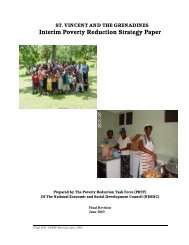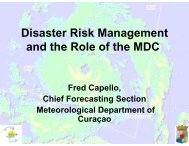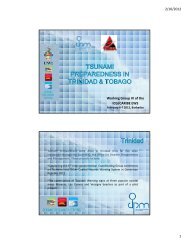The Anatomy of A Silent Crisis The Anatomy of A Silent Crisis
The Anatomy of A Silent Crisis The Anatomy of A Silent Crisis
The Anatomy of A Silent Crisis The Anatomy of A Silent Crisis
- TAGS
- anatomy
- www.bb.undp.org
Create successful ePaper yourself
Turn your PDF publications into a flip-book with our unique Google optimized e-Paper software.
Notes on report methodolog<br />
<strong>The</strong> PAGE 2002 model is based on a top-down approach with the following key components:<br />
• It relies on aggregate data on population and on economic growth for 8 regions in the world.<br />
• <strong>The</strong> basic inputs include emissions policy, adaptation and mitigation scenarios.<br />
• <strong>The</strong>re is not a break-down per economic sector: <strong>The</strong> model does not give results for water or<br />
agriculture or other independent sectors.<br />
• Impact in the model is the sum <strong>of</strong> three components: Economic loss, non-economic loss and cost<br />
<strong>of</strong> discontinuous events (i.e. tipping point events).<br />
Key indicators<br />
• Economic losses — i.e. benefits minus costs <strong>of</strong> climate change.<br />
• Social cost <strong>of</strong> carbon — i.e. the monetary indicator <strong>of</strong> the global damage done over time by the<br />
emission <strong>of</strong> one extra ton <strong>of</strong> carbon today.<br />
• Reduced growth rate — i.e. how much lower is GDP growth because <strong>of</strong> climate change.<br />
Assumptions defined under expert guidance<br />
For the purpose <strong>of</strong> the estimates for the Human Impact Report, a number <strong>of</strong> assumptions<br />
have been updated to reflect recent research findings. <strong>The</strong> original model dates back to 2002. <strong>The</strong><br />
updating <strong>of</strong> assumptions has been carried out under the guidance <strong>of</strong> the expert who is in charge <strong>of</strong><br />
PAGE 2002. <strong>The</strong> key assumptions include:<br />
• Discount rate increased to [0, 0.75, 1.5] from a constant <strong>of</strong> 0.1 to lower discount impact (in line<br />
with recommendations by Pr<strong>of</strong>. Hope).<br />
• Increased equity weights to correct for income difference in developing countries. <strong>The</strong>refore<br />
changed marginal utility to [0.5;1.25;2] from a constant <strong>of</strong> 1 (in line with recommendations by<br />
Pr<strong>of</strong>. Hope, see Hepburn and Cameron).<br />
• Updated tipping point scenarios to account for more realistic values: Threshold lowered to<br />
[1;3;6] degrees (from [2;5;8]). Risk increased to [10;20;30] percent (from [1;10;20]), Loss<br />
lowered to [1;5;10] <strong>of</strong> GDP (from [5;10, 20]) (in line with recommendations by Lenton and other<br />
tipping point experts).<br />
• Assumed that no adaptation takes place before 2010 — changed value to 0 (in line with<br />
recommendations by Pr<strong>of</strong> Hope).<br />
• Weather-related disasters attributable to climate change are underrepresented in the model. We<br />
therefore changed the mean value <strong>of</strong> the impact <strong>of</strong> a 2.5 degree increase in temperature from 1.3<br />
percent <strong>of</strong> GDP to 2.53 percent <strong>of</strong> GDP and set the Min value at 0.5 percent <strong>of</strong> GDP and the max at<br />
2.53 percent. (Based on experts indications that the Min value was too low, and that extreme events<br />
were underrepresented in the model, found no indication that the Max value in the model was too<br />
high). See calculation below.<br />
91







